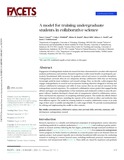A model for training undergraduate students in collaborative science
Metadata
Show full item recordAuthor
Casson, Nora J.
Whitfield, Colin J.
Baulch, Helen M.
Mills, Sheryl
North, Rebecca L.
Venkiteswaran, Jason J.
Date
2018-08-16Citation
Casson, Nora J., Colin J. Whitfield, Helen M. Baulch, Sheryl Mills, Rebecca L. North, and Jason J. Venkiteswaran. "A model for training undergraduate students in collaborative science." FACETs Journal (2018). DOI: 10.1139/facets-2017-0112.
Abstract
Engagement of undergraduate students in research has been demonstrated to correlate with improved academic performance and retention. Research experience confers many benefits on participants, particularly foundational skills necessary for graduate school and careers in scientific disciplines. Undergraduate curricula often do not adequately develop collaborative skills that are becoming increasingly useful in many workplaces and research settings. Here, we describe a pilot program that engages undergraduates in research and incorporates learning objectives designed to develop and enhance collaborative techniques and skills in team science that are not typical outcomes of the undergraduate research experience. We conducted a collaborative science project that engaged faculty advisors and upper year undergraduates at four institutions and conducted a review to assess the program’s efficacy. Students developed a broad suite of competencies related to collaborative science, above and beyond the experience of completing individual projects. This model also affords distinct advantages to faculty advisors, including the capacity of the network to collect and synthesize data from different regions. The model for training students to conduct collaborative science at an early stage of their career is scalable and adaptable to a wide range of fields. We provide recommendations for refining and implementing this model in other contexts.

